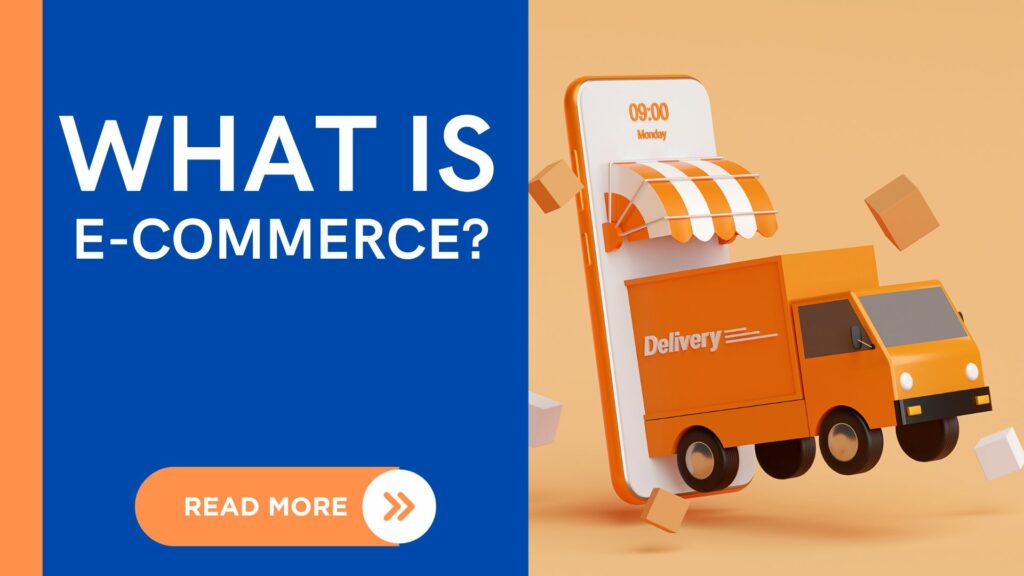Introduction
Within the expansive fabric of the digital world, a phrase known as “e-commerce” is resonating across the online activity corridors, revolutionizing our approach to conducting business. This phenomena has evolved in a way that is nothing short of revolutionary, changing the idea of buying and selling into a dynamic, global, digitally-driven experience.
What is E-commerce? It’s a portmanteau of electronic commerce, which is the meeting point of technology and business, with transactions taking place online. E-commerce has evolved from its early internet beginnings to its current ubiquitous nature. It has overcome barriers posed by location, reshaped corporate strategies, and reinterpreted the fundamentals of customer relationships.
The Genesis of E-commerce
Electronic commerce, or e-commerce, started off small in the early days of the internet. The emergence of online purchasing may be dated to the 1970s and 1980s, when people started experimenting with electronic transaction processing. But with the development of safe online transaction protocols and the general use of the internet, e-commerce really took off in the 1990s.
What is E-commerce
The term “e-commerce” so we are describing what is e-commerce the exchange of products and services via the internet. It covers a wide range of tasks, such as supply chain management, digital marketing, electronic payments, and online shopping. The principal aim is to enable transactions between buyers and sellers in an online environment, surpassing temporal and spatial limitations.
The Dynamics of Online Transactions
what is E-commerce? mostly uses internet platforms that function as virtual stores. These online stores include goods and services together with comprehensive descriptions, pictures, and prices. From the comfort of their devices, customers may peruse the catalog, make decisions, and start transactions.
A key component of safe transaction facilitation are electronic payment gateways. These gateways handle payments using encrypted connections, guaranteeing the integrity and privacy of financial data. Credit cards, digital wallets, and other online payment options provide customers more options for completing purchases, and they have grown to be essential parts of the E-commerce ecosystem.
E-commerce Models
E-commerce has several forms, each suited to certain customer demands and corporate configurations. Business-to-Consumer (B2C) e-commerce refers to online retail transactions that take place between companies and individual customers. Business-to-business, or B2B, e-commerce, is centered on business-to-business transactions. It aims to simplify procurement procedures and promote cooperation among enterprises in the business ecosystem. As we are telling, what is e-commerce.
Furthermore, using online platforms, consumers may sell directly to other consumers through consumer-to-consumer (C2C) e-commerce. Online marketplaces where people may list and sell secondhand products are an excellent example of this paradigm. The variety of E-commerce models illustrates how the online market may change to meet various company needs.
Advantages of E-commerce
There are several benefits that have emerged with the growth of e-commerce for both customers and businesses. It provides companies with a worldwide reach, opening up new markets and expanding their clientele. One major benefit of online transactions over traditional brick-and-mortar setups is their cost-effectiveness, which lowers overhead and boosts profitability.
On the other side, customers like the ease of buying whenever and wherever they choose. A better shopping experience is facilitated by the availability of a wide range of items, competitive price, and simplicity in making comparisons. Transparency is also promoted by e-commerce, as judgments about what to buy are informed by reviews and ratings.
Future Trends in E-commerce
The future of e-commerce appears to be one of constant innovation. With immersive and engaging platforms, emerging technologies like virtual reality (VR) and augmented reality (AR) are poised to completely change the way people purchase online. Artificial intelligence (AI) integration will improve customer service, predictive analytics, and customization by adjusting the E-commerce experience to individual preferences.
The rising use of smartphones has led to a boom in mobile e-commerce, or m-commerce. Social commerce is the blending of e-commerce and social media platforms, and it’s growing in popularity as a means of direct customer interaction for companies. The future of digital transactions will be shaped by the convergence of technology, user experience, and business strategy as e-commerce develops further. we told you, what is e-commerce?
Conclusion
To sum up, e-commerce is proof of the revolutionary potential of the digital era. E-commerce, from its beginning to the present and beyond, continues to be a dynamic force influencing how companies run and how customers interact with the market. It is clear that e-commerce is more than just a platform as we work our way through the complexities of online transactions and investigate the rapidly changing world of digital commerce. It is a driving force behind a widespread change in the way that trade and business are conducted in the twenty-first century. Come along on this adventure as we peel back the layers of e-commerce to discover its origins in the past and its upcoming advances.
Frequently Asked Questions
The term “e-commerce,” short for “electronic commerce,” describes the buying and selling of products and services done online. Through online platforms, electronic payment options, and secure protocols, companies and consumers deal in this virtual marketplace. Global trade and smooth contacts are made possible by e-commerce, which removes geographical restrictions. Traditional retail has been completely transformed by this innovative approach to commerce, which gives customers convenience, accessibility, and a wide selection of items while giving companies a dynamic platform to market and sell their products in the rapidly growing digital space.
Any organization that owns, runs, or oversees the digital platform that facilitates the exchange of goods and services between buyers and sellers is considered an E-commerce Operator for the purposes of the Goods and Services Tax (GST). These intermediaries are essential to online transactions and must abide by GST laws, which include gathering and sending taxes on sellers’ behalf.
As more and more customers choose the ease of online buying, e-commerce is becoming more and more dominant over physical retailers. Traditional brick-and-mortar businesses have issues in the competitive marketplace because to the continual shift in consumer behavior brought about by the convenience of access, huge product range, and smooth transactions.
E-commerce started in the 1970s and became more popular in the 1990s as the internet became widely used, revolutionizing global trade.
Electronic commerce, or e-commerce for short, is the digital exchange of products and services via the internet. It includes online payments, markets, and online transactions.
ई-कॉमर्स, या इलेक्ट्रॉनिक कॉमर्स, इंटरनेट पर सामान और सेवाओं की खरीददारी और बिक्री को दर्शाता है, जिसमें आनलाइन लेन-देन और भुगतान शामिल हैं।




